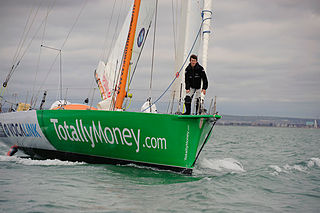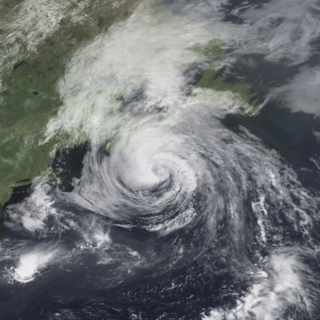1968 transatlantic crossing
On March 29, 1968, Vihlen departed Casablanca, Morocco, in his 5-foot, 11-inch (1.8 m) sailboat April Fool. Over the course of 84 days he sailed some 4,100 miles (6,600 km) before his progress was thwarted by winds and currents. Vihlen was able to approach to within 6 miles (9.7 km) of Miami on the night of June 20 but he was pushed back to sea by offshore winds and the currents of the Gulf Stream. The United States Coast Guard launched a search for the sailor on the morning of June 21 at the request of his parents. He was first spotted by a party aboard the First Edition, a boat owned by Fort Lauderdale publisher Ted Gore who gave Vihlen food and water. Gore offered to tow Vihlen to shore but the sailor refused. Vihlen and April Fool eventually were taken aboard the United States Coast Guard Cutter Cape Shoalwater and then Vihlen transferred to the fishing boat Sea Wolf where his son and wife were waiting for him. At the time of the voyage, Vihlen was a co-pilot for Delta Air Lines living in Homestead, Florida. [2] [3]
The voyage is described in Vihlen's book April Fool, or, How I Sailed from Casablanca to Florida in a Six-foot Boat. [4]
1993 transatlantic crossing
In 1993, he chose to leave from the U.S. coast and headed for England, crossing the North Atlantic in a boat, named Father's Day, that was just 5 feet 6 inches (1.68 m) long. The story of this four-month journey is told in Vihlen's book The Stormy Voyage of Father's Day (written with the help of Joanne Kimberlin).
Father's Day was originally built at 5 feet 6 inches long. On Vihlen's first attempt out of St. John's, Newfoundland, he met his rival and newfound friend Tom McNally who was also pursuing the record of crossing the North Atlantic from West to East. Tom's boat the, Big C, was 1½ inches smaller than the Father's Day. The first attempt out of Cape Cod was thwarted by the U.S. Coast Guard. Vihlen decided to leave from Canada where the distance was shorter, the currents were closer and the U.S. Coast Guard was absent. But he failed on his second attempt due to light and variable winds. He went home and cut 2 inches off of his boat and later set out again from St. John's, Newfoundland sailing to Falmouth, England in a 5-foot 4 inch sailboat taking 115 days. This trip earned him the record for the shortest boat to have crossed the Atlantic; the record for the smallest vessel by volume is held by Hannes Lindemann who crossed the Atlantic in a folding kayak.

Circumnavigation is the complete navigation around an entire island, continent, or astronomical body. This article focuses on the circumnavigation of Earth.

A catboat is a sailboat with a single sail on a single mast set well forward in the bow of a very beamy and (usually) shallow draft hull. Typically they are gaff rigged, though Bermuda rig is also used. Most are fitted with a centreboard, although some have a keel. The hull can be 3.7 to 12.2 metres long with a beam half as wide as the hull length at the waterline. The type is mainly found on that part of the Eastern seaboard of the USA from New Jersey to Massachusetts.

Proas are various types of multi-hull outrigger sailboats of the Austronesian peoples. The terms were used for native Austronesian ships in European records during the Colonial era indiscriminately, and thus can confusingly refer to the double-ended single-outrigger boats of Oceania, the double-outrigger boats of Island Southeast Asia, and sometimes ships with no outriggers or sails at all.

An outport is the term given for a small coastal community in the Canadian province of Newfoundland and Labrador. Originally, the term was used for coastal communities on the island of Newfoundland, but the term has now been adopted for those on the mainland area of Labrador as well.

In sailing, a boom is a spar (pole), along the of a fore and aft rigged sail, that greatly improves control of the angle and shape of the sail. The primary action of the boom is to keep the foot flatter when the sail angle is away from the centerline of the boat. The boom also serves as an attachment point for more sophisticated control lines. Because of the improved sail control it is rare to find a non-headsail without a boom, but lateen sails, for instance, are loose-footed. In some modern applications, the sail is rolled up into the boom for storage or reefing.

The Shields, also called the Shields 30 and the Shields One-Design, is an American trailerable sailboat that was designed by Olin Stephens of Sparkman & Stephens as a one design racer and first built in 1962.
The sport and practice of single-handed sailing or solo sailing is sailing with only one crewmember. The term usually refers to ocean and long-distance sailing and is used in competitive sailing and among cruisers.

The Sunday Times Golden Globe Race was a non-stop, single-handed, round-the-world yacht race, held in 1968–1969, and was the first non-stop round-the-world yacht race. The race was controversial due to the failure of most competitors to finish the race and because of the apparent suicide of one entrant, Donald Crowhurst; however, it ultimately led to the founding of the BOC Challenge and Vendée Globe round-the-world races, both of which continue to be successful and popular.
Kenichi Horie is a Japanese solo yachtsman. In 1962 he became the first person to sail solo and non-stop across the Pacific Ocean. He has made other significant solo voyages, usually involving boats exhibiting some sort of environmentally friendly theme, including his 2008 voyage across the Western Pacific Ocean in a wave-powered boat.

Cape Horn is the southernmost headland of the Tierra del Fuego archipelago of southern Chile, and is located on the small Hornos Island. Although not the most southerly point of South America, Cape Horn marks the northern boundary of the Drake Passage and marks where the Atlantic and Pacific Oceans meet.

The 1982 Florida subtropical storm, officially known as Subtropical Storm One, was the only subtropical cyclone of the exceptionally inactive 1982 Atlantic hurricane season. The storm originated from two different systems around the Gulf of Mexico and Caribbean on June 16. The systems merged into trough while a circulation began to form off the coast of Florida on June 18. The depression made landfall in Florida and strengthened into a storm over land. The storm entered the Atlantic Ocean and headed to the northeast, becoming extratropical on June 20 near Newfoundland. The storm was the only system of 1982 to affect the eastern half of the United States, and it caused three fatalities and caused $10 million in damage.

Michael Perham is an English sailor and adventurer from Potters Bar. In 2007 at the age of 14 he became the youngest person in the world to successfully sail across the Atlantic Ocean single-handedly, beating the record set in 2003 by British sailor Seb Clover. In 2009 at the age of 17 he became the youngest person to sail around the world solo. Perham's second record surpassed that of Zac Sunderland, an older 17-year-old American, set only six weeks earlier. Following this, Perham's adventures included driving around the world and racing in many offshore races, most notably the Sydney to Hobart yacht race in 2011 where his team placed second in class.

Hurricane Bertha caused minor damage in the United States, Bermuda, and Atlantic Canada in July and August 1990. The third tropical cyclone, second named storm, and first hurricane of the 1990 Atlantic hurricane season, Bertha developed from a frontal low pressure area offshore of North Carolina on July 24. Initially subtropical, it slowly acquired tropical characteristics while tracked southeast and then southwestward. By early on July 27, the cyclone was re-classified as a tropical depression. Following its transition, the depression intensified and was upgraded to Tropical Storm Bertha on July 28. The storm then curved northeastward and rapidly strengthened. Bertha became a hurricane early on July 29, though it weakened back to a tropical storm later that day. On the following day, Bertha re-intensified into a hurricane and peaked as an 80 mph (130 km/h) Category 1 hurricane on July 31.

Zachary Tristan Sunderland is an American former sailor who was the first person under the age of 18 to sail solo around the world. Sunderland completed his trip after 13 months and 2 days at sea on July 16, 2009 at age 17. The record was previously held by Australian David Dicks, and was surpassed on August 27, 2009 by Michael Perham of England. Sunderland is the youngest American to complete a circumnavigation, surpassing Brian Caldwell, who finished in 1996 at age 20. However, Sunderland's record was not recognized by Guinness World Records, or by the World Sailing Speed Record Council.

Hurricane Able was the first named tropical cyclone in the Atlantic hurricane database, and was also the first of six major hurricanes in the 1950 Atlantic hurricane season. Its development was confirmed on August 12 by the Hurricane Hunters, which is a group that intentionally flies into a hurricane for observations. Hurricane Able initially threatened to strike the Bahamas, but instead turned to the northwest and later to the northeast. As it neared the Outer Banks, Able reached peak winds of 125 miles per hour (201 km/h), equivalent to a modern-day Category 3 hurricane on the Saffir-Simpson hurricane wind scale. After brushing those islands and Cape Cod, Able moved ashore on Nova Scotia as a minimal hurricane. It later crossed Newfoundland and dissipated on August 24.
James Wharram was a British multihull pioneer and designer of catamarans.
Erling Tambs was a Norwegian writer and sailor.

The F-27 Sport Cruiser is an American trailerable trimaran sailboat that was designed by New Zealander Ian Farrier in 1984–1985.
The Cape Cod Cat, also called the Cape Cod Cat 17 and the Hermann Cat, is an American trailerable sailboat that was designed by Charles Whittholz as a day sailer/cruiser and first built in 1968.













